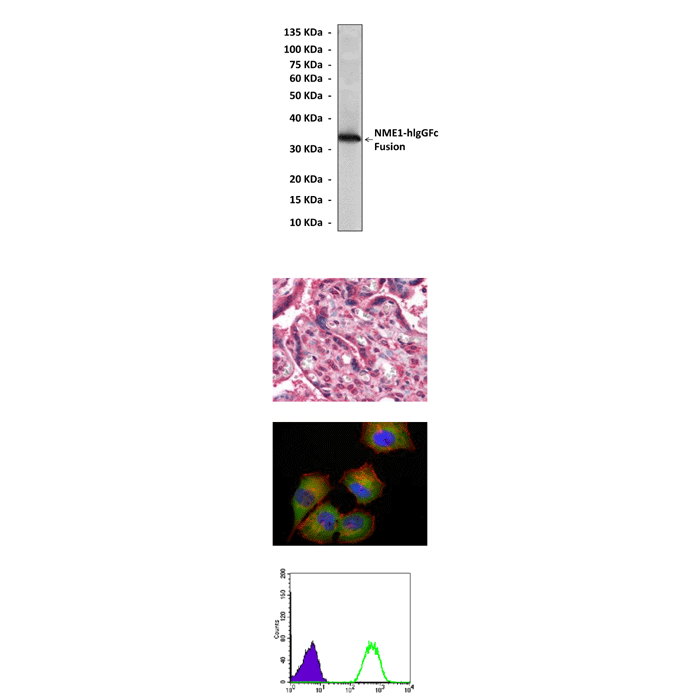Anti-NME1/NM23-H1: Mouse NME/MN23-H1 Antibody |
 |
BACKGROUND Nucleoside diphosphate kinases (NDP kinase/NDPK/Nm23/Awd) are a large family of nucleotidyl phosphotransferases that possess a high degree of sequence and structural conservation, whose biochemical role is to use ATP to generate a different nucleoside triphosphate. Each gene encodes an approximately 17-kDa to 20-kDa polypeptide, 4–6 of which folds into homomultimers, the native form of the enzymes. With high efficiency and broad substrate specificity NDPKs catalyze the transfer of γ-phosphates between ribo- and deoxyribonucleotides using a conserved histidine residue as the catalytic phosphate donor/acceptor. It has been assumed for decades that the primary physiological role of NDPKs is concerned with the general homeostasis of cellular nucleoside triphosphates. However, numerous additional biochemical and biological studies have concluded that NDPKs also serve as regulatory proteins not necessarily connected to nucleoside phoshorylation, e.g., in normal Drosophila melanogaster development, and in the induction and progression of tumors. Indeed, the matriarch of the family, Nm23-1/NDPK-A, was originally cloned as a metastasis suppressor. NDPKs are also implicated in signal transduction, transcriptional and translational control, and in regulatory interactions with an assortment of protein partners. The two most widely studied human NDPK genes NME1 and NME2 encode NM23-H1/NDPK-A and NM23-H2/NDKP-B, respectively. Both proteins are ubiquitous but differentially expressed according to the tissue considered, together providing the majority (>95 percent) of NDPK activity in cells. NME1 and NME2 are 88 percent identical in sequence and are closely linked on chromosome 17q21.3. Each gene encodes 152 amino acid long peptides, which, when assembled into identical three-dimensional native hexameric structures, carry out identical phosphotransferase reactions. Hence, the A and B proteins are presumed to function in a similar if not identical manner, acting independently and/or together.1
Nometastatic gene 23-H1 (NME1, also known as nm23-H1) is a member of the NDK family. Although initially thought of as a housekeeping gene that maintains cellular pools of nucleoside triphosphates, NME1 has been demonstrated to be a wide-spectrum tumor metastasis suppressor gene that plays an important role in suppressing the invasion and metastasis of tumor cells. NME1 regulates a critical step during cytokinesis. NME1acts to provide a local source of GTP for the GTPase dynamin. Loss of NME1in diploid cells leads to cytokinetic furrow regression, followed by cytokinesis failure and generation of tetraploid cells. In the absence of p53 signaling, the tetraploid cells resulting from loss of NME1continue cycling and develop classic hallmarks of tumor cells. Thus loss of NME1, an event suspected to promote metastasis, may additionally function at an earlier stage of tumor development to drive the acquisition of chromosomal instability.2 In addition, it was shown that NME1 is involved in erythroid development.3 It has also been demonstrated that NME1 is expressed in human first-trimester placenta. NME1 plays important role at the maternal–fetal interface, especially on invasion of the human extravillous cytotrophoblasts (EVCTs). NME1 has been identified in both human trophoblast cells and decidual stromal cells (DSCs) in early pregnancy. NME1 can inactivate the phospho-extracellular signal-regulated kinase 1/2 (P-ERK1/2) in trophoblasts in a time-dependent manner. NME1 expressed in trophoblasts and DSCs controls the inappropriate invasion of human first-trimester trophoblast cells via MAPK/ERK1/2 signal pathway, and the overexpression of NME1 at maternal–fetal interface leads to pregnancy wastage.4
REFERENCES
Nometastatic gene 23-H1 (NME1, also known as nm23-H1) is a member of the NDK family. Although initially thought of as a housekeeping gene that maintains cellular pools of nucleoside triphosphates, NME1 has been demonstrated to be a wide-spectrum tumor metastasis suppressor gene that plays an important role in suppressing the invasion and metastasis of tumor cells. NME1 regulates a critical step during cytokinesis. NME1acts to provide a local source of GTP for the GTPase dynamin. Loss of NME1in diploid cells leads to cytokinetic furrow regression, followed by cytokinesis failure and generation of tetraploid cells. In the absence of p53 signaling, the tetraploid cells resulting from loss of NME1continue cycling and develop classic hallmarks of tumor cells. Thus loss of NME1, an event suspected to promote metastasis, may additionally function at an earlier stage of tumor development to drive the acquisition of chromosomal instability.2 In addition, it was shown that NME1 is involved in erythroid development.3 It has also been demonstrated that NME1 is expressed in human first-trimester placenta. NME1 plays important role at the maternal–fetal interface, especially on invasion of the human extravillous cytotrophoblasts (EVCTs). NME1 has been identified in both human trophoblast cells and decidual stromal cells (DSCs) in early pregnancy. NME1 can inactivate the phospho-extracellular signal-regulated kinase 1/2 (P-ERK1/2) in trophoblasts in a time-dependent manner. NME1 expressed in trophoblasts and DSCs controls the inappropriate invasion of human first-trimester trophoblast cells via MAPK/ERK1/2 signal pathway, and the overexpression of NME1 at maternal–fetal interface leads to pregnancy wastage.4
REFERENCES
1. Lascu, I. et al: J. Bioenerg. Biomembr. 32:213–14, 2000
2. Conery, A.R. et al: Proc. Natl. Acad. Sci. USA 107:15461-6, 2010
3. Postel, E.H. et al: Mol. Cell. Biochem. 329:45-50, 2009
4. Xie, K.M. et al: Reproduct. 139:799-808, 2010
2. Conery, A.R. et al: Proc. Natl. Acad. Sci. USA 107:15461-6, 2010
3. Postel, E.H. et al: Mol. Cell. Biochem. 329:45-50, 2009
4. Xie, K.M. et al: Reproduct. 139:799-808, 2010
Products are for research use only. They are not intended for human, animal, or diagnostic applications.
Параметры
Cat.No.: | CP10332 |
Antigen: | Raised against recombinant human NME1 fragments expressed in E. coli. |
Isotype: | Mouse IgG1 |
Species & predicted species cross- reactivity ( ): | Human, Mouse, Rat |
Applications & Suggested starting dilutions:* | WB 1:1000 IP n/d IHC 1:50 - 1:200 ICC 1:50 - 1:200 FACS 1:50 - 1:200 |
Predicted Molecular Weight of protein: | 18 kDa |
Specificity/Sensitivity: | Detects endogenous NME1 proteins without cross-reactivity with other family members. |
Storage: | Store at -20°C, 4°C for frequent use. Avoid repeated freeze-thaw cycles. |
*Optimal working dilutions must be determined by end user.
Документы
Информация представлена исключительно в ознакомительных целях и ни при каких условиях не является публичной офертой








